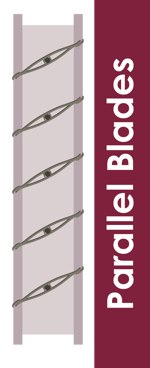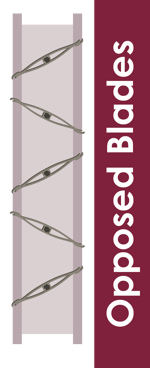Learn more about blade orientation and how it can affect a control damper's performance.
 Blade Action for HVAC Dampers
Blade Action for HVAC Dampers
Parallel or opposed? When choosing HVAC dampers, this question may seem like the least of your worries. The orientation of your blades has minimal effect on the damper in the open position, but the way they come together is important when they close. This is where the control damper’s blade orientation becomes important.
Starting a new project? Contact Air Balance about our line of control dampers. Let's work together to meet your requirements!
Parallel and Opposed
Blade orientation describes how a manufacturer installs blades in a control damper or adjustable louver. The blade orientation can be parallel or opposed.
Parallel orientation means that every blade moves the same way when opening and closing. Every blade will be at the same angle in the fully open position. During closure, the front edge of each blade will come together with the back edge of the blade below it. These edges overlap to close off the damper, giving the blades a flat profile when fully closed. We often depict dampers with parallel blades because the blades move uniformly across the damper's face.
In opposed orientation, each blade will have a different blade angle than its neighbors. Imagine assigning a number to each blade. Odd blades will all have the same blade angle and even blades will also have the same angle. When closed, the resulting blades will create a zig-zag shape down the height of the damper.
 While opening and closing, the odd blades will move in the opposite direction of the even blades. Like the parallel blades, the edges of the opposed blades will overlap when the damper closes.
While opening and closing, the odd blades will move in the opposite direction of the even blades. Like the parallel blades, the edges of the opposed blades will overlap when the damper closes.
The Difference Between Parallel and Opposed
While the results may look the same, these two blade orientations have tradeoffs that make them better suited for certain applications. When opening and closing, parallel blades minimize pressure drop through the damper’s blades. This makes parallel blades the best orientation for maintaining air flow.
In opposed orientation, the movement of the opposing blades will increase pressure drop as the damper opens and closes. This can put undue strain on your HVAC system every time the damper operates. Parallel blade orientation is best for directing airflow in quick bursts.
While they may affect airflow, opposed blades serve a key role in your HVAC system. The opposed blade action can modulate airflow and provide more closing torque for the damper. Tighter seals between each blade will minimize air leakage. Opposed blade orientation is best for modulating airflow at different points in the duct.
Learn how air leakage affects air performance with our Newsstand article: Air Leakage - The Performance Killer.
.png?width=600&height=314&name=MCDLG%20-%20parallel-opposed%20(Resize).png)
Choosing the right blade orientation will ensure your dampers are designed for peak HVAC efficiency, saving you money over the lifetime of the system.
There are more options to consider than blade orientation. Learn the various options and accessory parts available for control dampers with our Newsstand article: Options for Control Dampers.
For more on control dampers, read these Newsstand articles:
- Air Leakage - The Performance Killer
- Maintaining Control Dampers
- The Condenser - A Closer Look at Blade Seals
Which do you prefer: parallel blades or opposed blades? Which blade orientation is more common in your projects? Share your thoughts in the Comments section below. Let's start a conversation on dampers!
Do you have a question on something we haven't covered here? Or maybe you need help from industry experts? MCDLG can help. Contact us by clicking on the button below.
.webp?width=91&height=70&name=MCDLG%20Logo%20(Resize).webp)
.webp)




